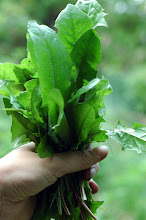
These ingredients are picked fresh from my garden and are grown in soil that is free of pesticides, herbicides and growth chemicals; in other words, they are grown as naturally as possible. I use whichever plants are growing at the time and so the formula will vary a little from batch to batch. Rarely do I run out of spinach in the garden and when I do, I buy organic only until my garden catches up.
I use STEVIA, a natural sweetener, to sweeten the drink so there are very few calories to speak of.
The ingredients are listed from highest concentration to least:
Spinach: Spinach is known as a rich source of iron and calcium. Spinach has a high nutritional value and is extremely rich in antioxidants, especially when fresh. It is a rich source of vitamin A (and lutein), vitamin C, vitamin E, vitamin K, magnesium, manganese, folate, iron, vitamin B2, calcium, potassium, vitamin B6, folic acid, copper, protein, phosphorus, zinc, niacin, selenium and omega-3 fatty acids. Recently, opioid peptides called rubiscolins have also been found in spinach. It is a source of folic acid (Vitamin B9), and this vitamin was first purified from spinach.
Yellow Dock: It is a blood cleanser, purifier, and builder; tones the entire system. It is high in Vitamin C and iron compound-one of the best blood builders. It is good for all skin problems. It dissolves mucus and moves it through kidneys. It is an excellent cleanser of the lymphatic system. It dissolves glandular and other tumors. Kill parasites which contribute to cancer. It is used for hepatitis. The plant is edible and the leaves are used for green drink and other eating.
French Sorrel: In traditional folk medicine, garden sorrel was used as an antiseptic. Because of its high vitamin C content, it was (correctly) believed to prevent scurvy. French sorrel was also used to cure scurvy, cleanse the blood, and promote urine flow. Sorrel is also used externally to cure skin disorders and promote a clear complexion. In addition to being rich in vitamin C, both sorrels are high in vitamin A, and are a good source of iron. French sorrel is also an excellent source of fiber.
Mint: One of the oldest and most popular remedies for simple colic and minor bloat in children and adults. It is good for all digestive problems, helps stomach pain caused by indigestion and is soothing to the stomach. It expels stomach gas and colon gas. It cleanses and tones the body. It promotes relaxation. It strengthens nerves and heart muscles.
Alfalfa: The name alfalfa means “Father of all Foods.” It has been called the King of plants because it is extremely rich in vitamins and minerals including iron, calcium, magnesium, phosphorus, sulfur, chlorine, sodium, potassium, silicon, and trace elements. It’s a good source of carotene (Vitamin A) and vitamin K. It has eight of the essential amino acids and the highest chlorophyll content of any plant. It permits rapid assimilation of plant elements; this is one of the reasons alfalfa is used as a base in many combinations and in vitamin formulas. Prevents tooth decay and helps rebuild decayed teeth, contains natural fluoride.
Dandelion: The dandelion we are talking about really is that little yellow weed in your lawn. All its parts are used–the leaves, flower and roots. It can be used fresh in green drinks and salads. It is one of the best blood purifiers and builders available. It is high in vitamins and minerals, especially calcium. It contains all the nutritive salts for the blood. Dandelion restores and balances the blood so anemia that is caused by deficiencies of these blood salts disappears. The herb for low blood pressure, helps build energy and endurances. Overweight people when losing weight can become over acidic. These acids in the blood are destroyed by dandelion. It is one of the best liver cleansers. It increases the activity of the liver and the flow of bile into the intestines. It increases activity of the pancreas and the spleen. It is good for the female organs. It helps open urinary passages. It is used to treat skin diseases. It is fantastic for use in hepatitis.
Holy Basil: The leaves are a nerve tonic and also sharpen memory. The leaves strengthen the stomach and induce copious perspiration. Holy Basil has strengthening effect on the kidney. Basil has a beneficial effect in cardiac disease and the weakness resulting from them. It reduces the level of blood cholesterol.
Holy basil is classified as a rasayana, an herb that nourishes a person’s growth to perfect health and promotes long life. For perhaps three thousand years, holy basil has been considered one of India’s most powerful herbs. The daily use of this herb is believed to help maintain the balance of the chakras (energy centers) of the body. It is acclaimed as possessing sattva (energy of purity) and as being capable of bringing on goodness, virtue, and joy in humans. In the Puranas (a sacred Hindu text), everything associated with the plant is holy, including water given to it and the soil in which it grows as well as all its parts, among them leaves, flowers, seed, and roots.
Additionally, Lamb's Quarters, Romaine Lettuce, Sweet Basil, Lemon Balm and Kale just got big enough to be added to the mix.
Most of the information about these herbs was taken from “The How to Herb Book” by Velma J. Keith and Monteen Gordon. The rest was collected from different on-line sources so it can all be verified with a little research.



